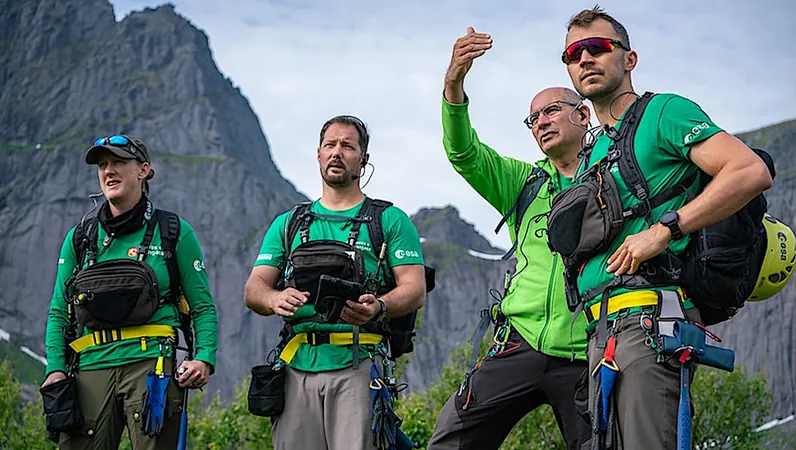
Unveiling the Moon: ESA's Groundbreaking Training for Artemis Astronauts
2025-09-18
Author: Wei Ling
Preparing Astronauts for Lunar Exploration
When it comes to exploring the Moon, a new wave of training is setting astronauts up for success. The European Space Agency (ESA) is taking lunar geology lessons to the next level with its PANGAEA program, designed to equip astronauts with crucial scientific skills needed for the upcoming Artemis missions. This training emphasizes the interplay of astrobiology, astrogeology, and astrochemistry—key components as astronauts prepare for the mysteries lying in the lunar surface.
From Earth to the Moon: The PANGAEA Experience
Recently, geology experts Cindy Evans and Juliane Gross traded their desks at NASA's Johnson Space Center for the stunning landscapes of Norway's Lofoten Islands. Here, they dove into the geological intricacies relevant to lunar missions, handling everything from cosmic dust to ancient Moon rocks. As leaders in sample curation for Artemis III, they highlight the immersive nature of their training alongside astronauts and planetary scientists.
Why Geology Training Matters
Cindy Evans emphasizes the importance of astronauts being both scientists and explorers on the lunar surface. With challenging terrains ahead, they'll need in-depth geology knowledge and “muscle memory” for field skills to manage the complexities of their tasks without direct guidance from Mission Control. As they traverse the Moon's rugged highlands, their ability to make quick, informed decisions will be vital.
Learning from Earth: Key Analogues to the Moon
Juliane Gross points out that the chosen geological features in the Lofoten Islands—specifically the anorthosite complex—serve as a critical analogue for the rocky landscapes the Artemis crew will encounter during lunar expeditions. This hands-on training is pivotal, empowering astronauts to make informed choices about sample collection and navigation across the lunar surface.
Massive Benefits of the PANGAEA Training
Both Evans and Gross were taken aback by the remarkable geological formations they encountered. Exploring ancient magma chambers offered firsthand insights into the geological processes relevant to lunar exploration. The well-structured training program, cohesive teamwork, and an enthusiastic atmosphere made the experience unforgettable.
Future Missions: Building Momentum
The PANGAEA program isn’t just an isolated training exercise; it’s integrated into NASA’s broader astronaut education, ensuring that both new and existing astronauts are well-versed in the latest geological insights. This collaborative effort fosters a strong foundation as multiple agencies come together to reinforce each other’s training for future lunar missions.
Laying the Groundwork for Scientific Success
Preparations for the Artemis missions involve diverse training, including classroom sessions and hands-on experiences with lunar samples. Building a robust relationship with ground operations is equally imperative, allowing all team members, from flight directors to astronauts, to communicate effectively about geological tasks on the Moon.
Collaborative Exploration and Scientific Discovery
The Artemis missions will rely on strong partnerships and collaborative efforts to enhance lunar exploration efficiency. Evans and Gross note that exploration ignites scientific discovery, as each moonwalk will unveil new insights and sample collections that promise to deepen our understanding of the Solar System.
Cherishing Incredible Experiences
Reflecting on their amazing training journey, the duo expresses gratitude to ESA and the PANGAEA team for fostering friendships and teamwork. They look forward to building on their shared experiences, celebrating the warmth and humor among team members, including unforgettable moments shared with talented individuals.
The Future Awaits!
As the Artemis missions loom closer, the intersection of science and exploration promises to unveil new chapters in lunar research. With extensive training under their belts, astronauts are gearing up to make history—inspiring a new generation of scientists and explorers eager to unlock the secrets of the Moon.

 Brasil (PT)
Brasil (PT)
 Canada (EN)
Canada (EN)
 Chile (ES)
Chile (ES)
 Česko (CS)
Česko (CS)
 대한민국 (KO)
대한민국 (KO)
 España (ES)
España (ES)
 France (FR)
France (FR)
 Hong Kong (EN)
Hong Kong (EN)
 Italia (IT)
Italia (IT)
 日本 (JA)
日本 (JA)
 Magyarország (HU)
Magyarország (HU)
 Norge (NO)
Norge (NO)
 Polska (PL)
Polska (PL)
 Schweiz (DE)
Schweiz (DE)
 Singapore (EN)
Singapore (EN)
 Sverige (SV)
Sverige (SV)
 Suomi (FI)
Suomi (FI)
 Türkiye (TR)
Türkiye (TR)
 الإمارات العربية المتحدة (AR)
الإمارات العربية المتحدة (AR)